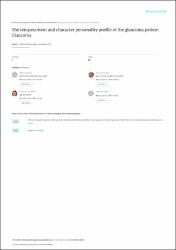| dc.contributor.author | Çakmak, Harun | |
| dc.contributor.author | Altınyazar, Vesile | |
| dc.contributor.author | Yılmaz, Suzan Güven | |
| dc.contributor.author | Omurlu, İmran Kurt | |
| dc.contributor.author | Kocatürk, Tolga | |
| dc.contributor.author | Yazıcı, Alper | |
| dc.contributor.author | Değirmenci, Cumali | |
| dc.contributor.author | Dündar, Sema Oruç | |
| dc.date.accessioned | 2019-10-17T07:08:41Z | |
| dc.date.available | 2019-10-17T07:08:41Z | |
| dc.date.issued | 2015 | en_US |
| dc.identifier.issn | 1471-2415 | |
| dc.identifier.uri | https://doi.org/10.1186/s12886-015-0117-9 | |
| dc.identifier.uri | https://hdl.handle.net/20.500.12462/7502 | |
| dc.description | Yazıcı, Alper (Balikesir Author) | en_US |
| dc.description.abstract | Background: To determine the temperament and character profile of glaucoma patients.
Methods: A total of 234 patients (104 with primary open angle glaucoma, and 130 control subjects without any ocular disease) were selected for this prospective, cross-sectional study. All the participants underwent a comprehensive ophthalmological examination, including the best corrected visual acuity, intraocular pressure measurement, gonioscopy, and visual field analysis. All the participants were given the Turkish version of the Temperament and Character Inventory (TCI). The TCI is a self-reported evaluate, with 240 true/false items measuring four domains of temperament; harm avoidance (HA), persistence (PS), novelty seeking (NS), reward dependence (RD), and three domains of character; self-transcendence (ST), cooperativeness (C), self-directedness (SD).
Results: The glaucoma patients achieved the higher scores than the controls for the HA and SD dimensions (p < 0.001 and p = 0.033). The glaucoma patients scored lower than the controls for the NS, P and ST dimensions (p < 0.001, p < 0.001 and p = 0.002). There were no differences in the RD and C scores between the patients and the controls (p = 0.944 and p = 0.343). There was no correlation between the duration of illness and the TCI dimensions. Disease severity was positively associated with HA (r = 0,220, p = 0,025) and the anticipatory worry (r = 0.227, p = 0.021) dimension.
Conclusions: Glaucoma patients had a different personality profile to healthy individuals. This may affect treatment compliance and is also important when coping with maladaptive patient attitudes. | en_US |
| dc.language.iso | eng | en_US |
| dc.publisher | Biomed Central Ltd | en_US |
| dc.relation.isversionof | 10.1186/s12886-015-0117-9 | en_US |
| dc.rights | info:eu-repo/semantics/openAccess | en_US |
| dc.subject | Glaucoma | en_US |
| dc.subject | Temperament and Character Inventory | en_US |
| dc.subject | Personality Profile | en_US |
| dc.title | The temperament and character personality profile of the glaucoma patient | en_US |
| dc.type | article | en_US |
| dc.relation.journal | Bmc Ophthalmology | en_US |
| dc.contributor.department | Tıp Fakültesi | en_US |
| dc.contributor.authorID | 0000-0001-8720-007X | en_US |
| dc.identifier.volume | 15 | en_US |
| dc.relation.publicationcategory | Makale - Uluslararası Hakemli Dergi - Kurum Öğretim Elemanı | en_US |


















